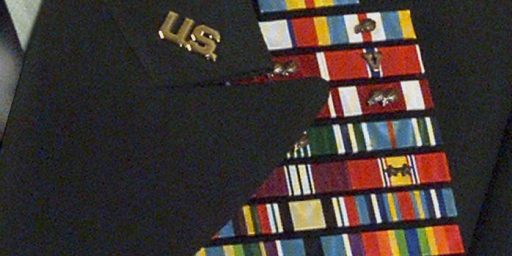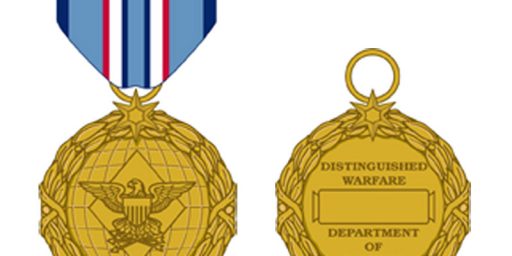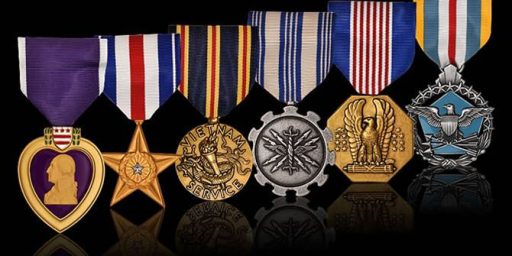Medals Authorized for Soldiers Participating in Hurricane Relief
Service members who participated in relief operations for Hurricanes Katrina and Rita have been authorized to wear the Humanitarian Service Medal and/or the Armed Forces Service Medal.
Storm-relief medals authorized (Army Times)
The Joint Staff has authorized the award of the Humanitarian Service Medal and Armed Forces Service Medal to soldiers, sailors, airmen, Marines and members of the Coast Guard — active, Guard and Reserve — who participated in relief operations for Hurricanes Katrina and Rita. The Humanitarian Service Medal is authorized for those who supported immediate relief operations in Alabama, Louisiana, Mississippi and Texas — east of 96 degree west longitude — from Aug. 29 to Oct. 13, 2005. The Armed Forces Service Medal is authorized for those who provided, or are providing, direct support to relief efforts for 30 consecutive days, or 60 nonconsecutive days anywhere in the United States from Aug. 27, 2005, to Feb. 27, 2006.
While I certainly don’t begrudge soldiers these awards, it is highly unusual to authorize two “I was there” medals for the same operation, even in wartime. Generally, one service or campaign medal is authorized per operation.
Times have changed for military awards. My dad spent twenty years in the Army, including a stint in Vietnam, retiring as a First Sergeant in 1982. Including the Meritorious Service Medal he was awarded upon retirement, he had five medals on his uniform (although he had several oak leaves representing multiple awards of the Army Commendation Medal plus multiple service stars on his Vietnam Service Medal). That was normal. My first battalion commander, also a Vietnam Vet, had maybe six or seven medals when I reported to Germany in 1989.
In the early 1980s, the Services created several new awards, including the various Achievement Medals, NCO Professional Development Ribbons, and medals for completing initial entry training. This was done because, after a longish period of peace, soldiers had few medals and medals were thought to boost morale. Of course, that’s generally true only of earned medals not those given out like candy.
I spent the first three years of my active duty stint with only the lowly Army Service Ribbon (dubbed “the Rainbow Ribbon” after its appearance) representing completion of Field Artillery Officer Basic Course. Considering that the mere fact I was at a unit meant that, by definition, I had completed said course, I valued that ribbon very lightly. Then, my unit got deployed to Desert Shield/Desert Storm. By the time it was all over with, I had eight awards on my “rack” — a Bronze Star, an Army Commendation Medal, National Defense Service Medal, Southwest Asia Service Medal (with three battle stars), Overseas Service Ribbon, the Rainbow Ribbon, and two Liberation of Kuwait Medals, one from the Saudis and another from the Kuwaitis–to go along with my Airborne and Air Assault wings.
Because of a rather generous awards policy–as demonstrated by the medals for flood relief–and a high operations tempo, it is not unusual to see mid-career soldiers with ten or more ribbons on their uniforms. It’s an interesting way to show at a glance what missions a soldier has participated in but one can’t help but wonder how much pride they instill, given how easily most are awarded.






John Kerry’s games leap to mind, unbidden. Your points about pride are well taken, but I submit that part of the awards system was damaged decades ago.
Further, I suggest that these two medals suggest a policy shift in what we expect our military to do when deployed. Have we devolved our military to a meals on wheels?
I thought the Armed Forces Service Medal was the one you got for going to Mass for four consecutive weeks.
After six years of service in mostly peacetime, (shortly after the vietnam war and into the early Reagan years, including being stationed offshore for the Iran hostage crisis) I had three as an enlisted man. (Left as E-5, pna E-6) Marksman, 4 year Good Conduct award, and WestPac deployment ribbon. This was Navy, of course… not sure how that differs from the ground pounder awards.
Yes, they give out a lot more now.
I retired from the Navy with about six. Most were for being in the right place at the right time.
I learned to see medals, ribbons, and letters of appreciation as among the few ways we had to reward people for good performance. The military doesn’t award monetary bonuses, Christmas checks, merit promotions, etc. Pinning on a medal is an opportunity to bring people forward before their peers and publicly acknowledge their good work. Also, medals count as “brownie points” when they are being considered for scheduled promotion (which is intensely competivie). Going up in rank means more money and prestige + job security, so giving people medals is a way to help them along.
I got the Army Service Ribbon at the end of AIT and then I also got an Army Achievement Medal my first year in the Guard. I later got an Armed Forces Reserve Component Achievement Medal which is the USAR/ARNG equivalent to a good conduct medal.
That was all I got the 6 years I was in but I was out before the ops tempo increased so much.
Let’s make sure that Michael Brown gets a couple of these and maybe a Medal of Freedom, while we’re at it.
I was a bit surprised at your statement, “In the early 1980s, the Services created several new awards, including the various Achievement Medals…” Until I read this post and did some research, I didn’t know that the Army and the Air Force didn’t have Achievement Medals until 1981, although I was aware of the creation of the Joint Service version in the early 80s since I worked at a Joint Service agency at the time.
FWIW, the Navy Achievement Medal (or NAM in Navy parlance) was established in 1961, and since it’s awarded to Marines as well as sailors, it was renamed the Navy and Marine Corps Achievement Medal in 1994, but I’m pretty sure folks still call it a NAM.
Oh, and for the record, when I retired in 1994, I had 11 ribbons, but that’s somewhat inflated since the Navy awards a ribbon for both pistol and rifle marksmanship. If you qualify as Expert, there’s also a medal to accompany each of the ribbons.
When I joined the Navy in 1967, the National Defense Service Medal was known as the “Geedunk” Medal, since everyone who enlisted at that time got one.
If you don’t know what “Geedunk” means, try Google.
After 17 years (AF) I have 19 ribons (13 are medals), one with the v device, many other devices, etc, etc, etc, but the one that meant the most to me was an achievement medal I recieved for a Saudi stint. It was one I didn’t expect and one for a time period I worked “above and beyond” if you will, with no expectation of any recognition what so ever. It meant a lot. The rest…thanks, nice to have.
Boyd: Interesting. The Navy and Air Force both award medals for marksmanship, for which the Army only gives “bolo badges.” The Air Force, generally, is pretty medal happy. My sense is that the Marines are on the opposite end of the spectrum, being pretty stingy with theirs.
I will recognize some awards, such as the AAM and ARCOM, are being awarded more generously. But once you have one, there are no more ribbons, just appurtenances.
I will also say there are more campaign medals, because our troops are in general a LOT more busy than they were 20 or 30 years ago. That, and the nature of the mission has changed. If you are drawing hazardous duty pay for 6 or more months, likely you are entitled to some sort of campaign medal.
As far as those authorized for hurricane relief, I am split. Any deployment or rapid deployment is a stressful experience, especially in CONUS. I suppose this is what the awards were originally created for. It just seems like the “campaign” was a only a short duration.
I agree with fizzix.
There is nothing wrong with awarding service with some form of recognition. I believe the Army still uses the three-year hash marks on the lower sleeve.
Now that I am in the civilian world, I wish I got the kind of token recognition that I got while in uniform.
Besides, wearing medals may look blindly impressive to civies, but to other service people, we generally know which ones are for valor and bravery and which ones are for service.